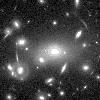Gravitational Lensing
It was Einstein who realised that gravity isn't only responsible for keeping our feet on the ground, but that it also governs the geometry and dynamics of the Universe. In his General Theory of Relativity, he showed that objects which produce a gravitational field (that is all objects that have mass) distort the geometry of space and time around them (Karl Schwarzschild, using Einstein's theory, was first to derive the resulting space-time geometry around isolated compact objects).
This discovery led directly to the prediction that light does not travel along a straight line if it passes close to such a gravitating body, but instead follows the shortest route along the distorted space-time "surface". This effect came to be called gravitational lensing (an analogy to the way in which an ordinary lens distorts light) and was experimentally verified within a few years of the publication of Einstein's theory when background stars close to the line of sight towards the Sun were observed, during a Solar eclipse, to be shifted from their normal positions on the sky.
 The effect of gravitational lensing can be dramatic if the body producing the gravitational field is very massive, often resulting in double or multiple images of a single source. The image on the right, obtained with the Hubble Space Telescope, shows many distorted arc-like features which are actually gravitationally-lensed images of background galaxies; their light being heavily distorted by the gravitational field generated by the foreground cluster of galaxies (just about every object in this photo is a galaxy).
The effect of gravitational lensing can be dramatic if the body producing the gravitational field is very massive, often resulting in double or multiple images of a single source. The image on the right, obtained with the Hubble Space Telescope, shows many distorted arc-like features which are actually gravitationally-lensed images of background galaxies; their light being heavily distorted by the gravitational field generated by the foreground cluster of galaxies (just about every object in this photo is a galaxy).
Microlensing
The effect is much less striking if the body responsible for the lensing effect (referred to as the "lens", naturally) is much less massive than a galaxy, as is the case for a star or planet. Objects located within our Galaxy that are less massive than about one million solar masses are predicted to produce lensing effects on angular scales of less than one-thousandth of an arc-second. Even though such small scales are beyond measurement with present optical telescopes one can still observe characteristic changes in the brightness of the background source. Because the actual distortion of the image itself is too small to be observable, this type of lensing is referred to as gravitational microlensing. (Observable image distortions are sometimes termed macrolensing, but are more commonly referred to simply as lensing.)
Since the lens is not actually required to be visible (only the source need be detectable) microlensing provides a powerful probe for the presence of dark matter. By looking for characteristic brightness changes in the light from stars in nearby galaxies one can deduce the nature of dark matter within our own Galaxy (or, more precisely, between the observer and background star). The probability of observing a microlensing event in our Galaxy due to the presence of dark matter is predicted to be of the order one in every million or so background stars. Therefore, by simultaneously monitoring millions of stars for indications of such variations one can use the observed frequency of microlensing to deduce the amount of dark matter in our Galaxy. In addition, the individual duration of each microlensing event, that is to say the time over which the increase in brightness of the background star exceeds a given factor, gives a crude indication of the mass of the intervening lens (statistically speaking, the more massive the lens the longer the microlensing event lasts as the lens crosses the line of sight to the source).
This is the technique used by several microlensing experiments currently in operation. Some of the experiments have already detected a number of microlensing events and analyses of the data so far indicate that between 10-100% of the dark matter predicted to exist in our Galaxy consists of objects in the mass range 0.2-2 Solar masses.
